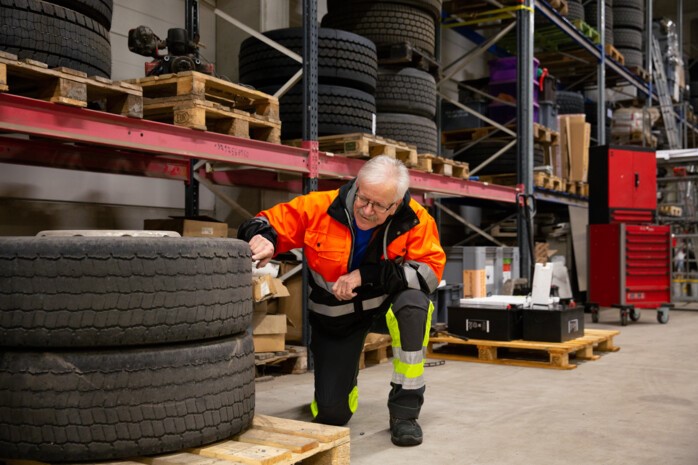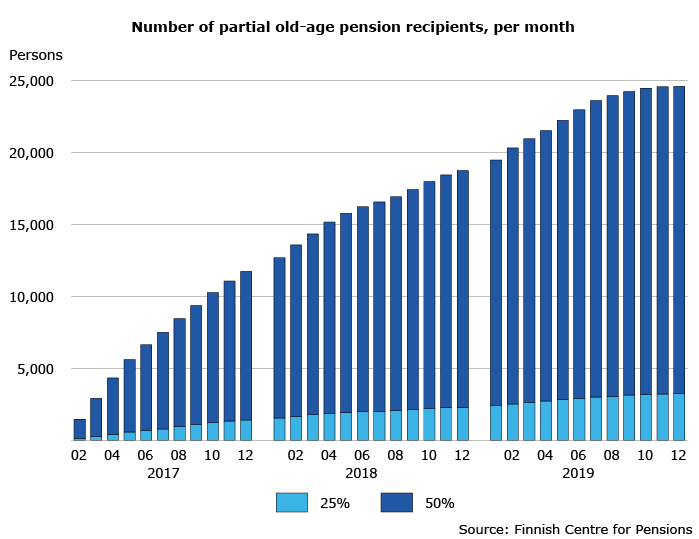Already 25,000 Finns drawing a partial old-age pension

At year-end 2019, the number of partial old-age pension recipients in Finland was 25,000, which is an increase of 6,000 from the end of 2018. Nearly all take out 50 per cent of their accrued old-age pension. The average monthly partial old-age pension was 800 euros and the median 720 euros, statistics of the Finnish Centre for Pensions show.
The partial old-age pension replaced the part-time pension in 2017.
One in ten 61-year-old or older chooses to take out a partial old-age pension. Many slightly older persons have taken it out early, before reaching their retirement age. More than 10,000 persons have taken out a partial old-age pension each year, so by now, it has been paid to more than 37,000 persons.
At year-end 2019, a total of 24,600 partial old-age pensions were in payment. This was 6,000 more than at year-end 2018. A total of 10,400 partial old-age pensions have terminated.
The partial old-age pension, when taken out early, reduces the full old-age pension amount permanently. The average monthly deduction for early retirement was 123 euros for younger persons, that is, for those born in 1958 who have a right to the pension.
“At most, younger persons who are eligible for the pension can take it out for as much as three years early. Although pensions are cut increasingly more, it does not seem to affect the behaviour of people,” development manager Jari Kannisto (Finnish Centre for Pensions) states.
Nine out of ten pensions have been taken early, that is, before the pension recipient has reached their retirement age. A considerable part of those who have taken out a partial old-age pension retired on an full old-age pension as soon as it was possible.
Two out of three continued working
Nearly 90 per cent of those who have taken out a partial old-age pension have taken out 50 per cent of their accrued old-age pension. That is why the average monthly partial old-age pension in 2019 was 800 euros. The median pension was 720 euros per month.
More than half (57%) of the recipients of the partial old-age pension are men. Compared to women, the shorter expected life span and the higher earnings of men may explain the high ratio of male recipients.
An ample two out of three partial old-age pension recipients continued working. Most of them work in the private sector.
“It seems that every third of those working cuts down on their working hours. If the downshifters continue working past their retirement age, this pension benefit works as intended. However, we don’t know yet if this is the case,” Kannisto explains.
Average years-of-service pension an ample 2,000 euros
The years-of-service pension came into force at the beginning of 2018. By the end of 2019, the benefit had been granted to 64 persons.
In 2019, a total of 27 new year-of-pensions started. On average, the monthly pension was 2,080 euros. At year-end, a total of 15 years-of-service pensions were in payment. Most pension recipients are men.
So far, the years-of-service pension has been able to last for only a few months before it has been converted into an old-age pension. In the future, the popularity of the earnings-related pension may grow as the retirement age for the old-age pension rises.

Partial old-age pension
- replaced the part-time pension in connection with the 2017 pension reform;
- offers a possibility for the 61-year-olds and older to take out a quarter (25%) or half (50%) of the pension they have earned so far;
- permanently reduces the full old-age pension by 0.4 per cent for each month that the pension is taken early;
- can be taken out after reaching the retirement age;
- if it is taken late, after reaching one’s retirement age, the share taken out is increased by 0.4% for each month that it is deferred; and
- does not limit how much you can work or earn, you can be unemployed or work while drawing the pension.
Years-of-service pension
- can be granted to persons aged 63 or more (born in 1955 or later);
- can be granted after a 38-year-long working life of work that requires great mental or physical effort;
- requires a medical statement that the ability to work has been reduced;
- is the pension pot earned up to the time that the benefit is taken out; and
- is paid until the person reaches their retirement age.
New pension benefits and the pension reform (Etk.fi website)
More information
Jari Kannisto, Development Manager, +358 29 411 2232, jari.kannisto(at)etk.fi
Photo: Katri Lehtola
The figures in the press release have been updated 31 March at 10 am. The correct information is that 24,600 persons received a partial old-age pension at the end of 2019, not 25 500 as indicated in the original text. This is 6,000 more than at the end of 2018, not 5000.